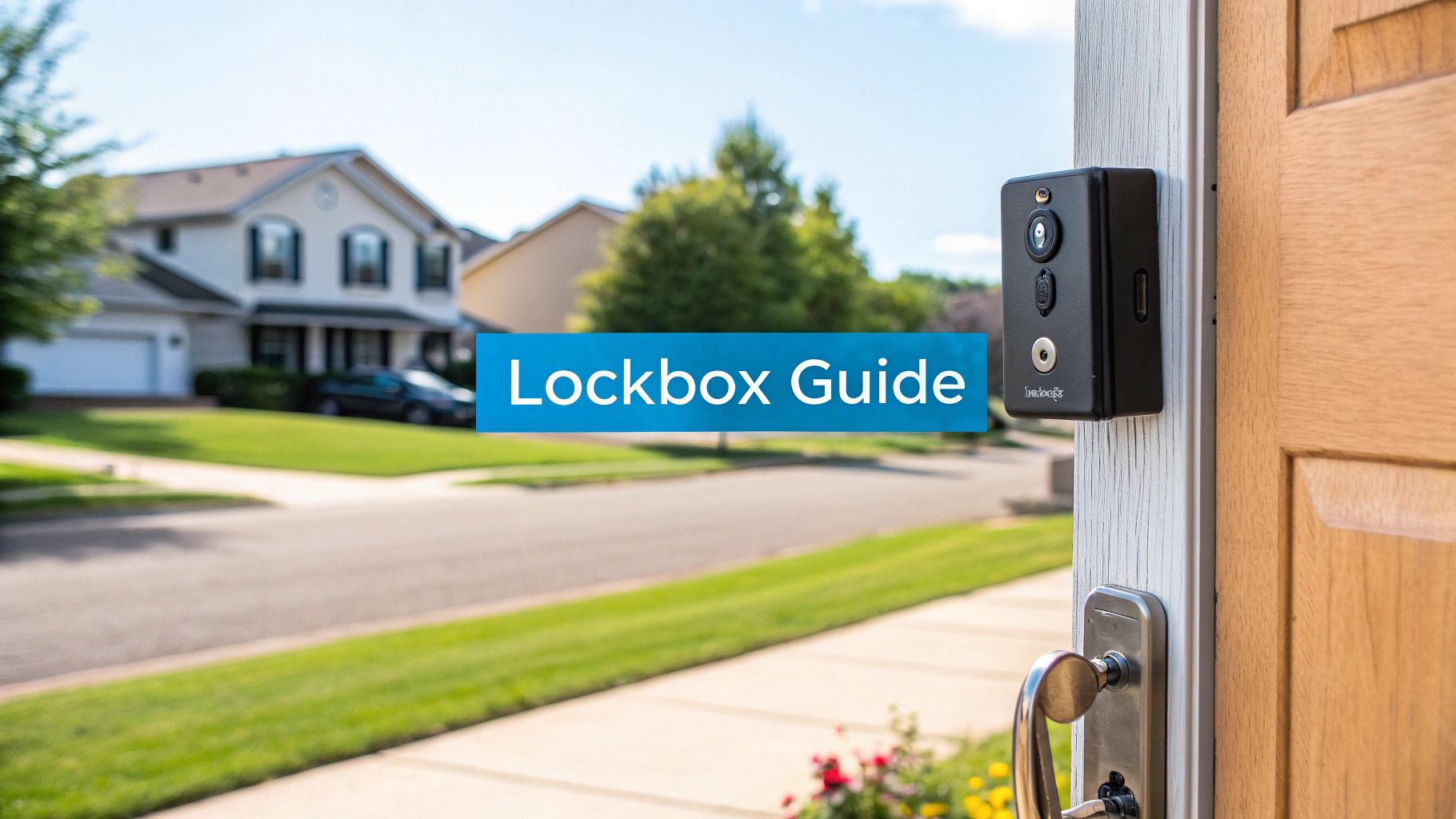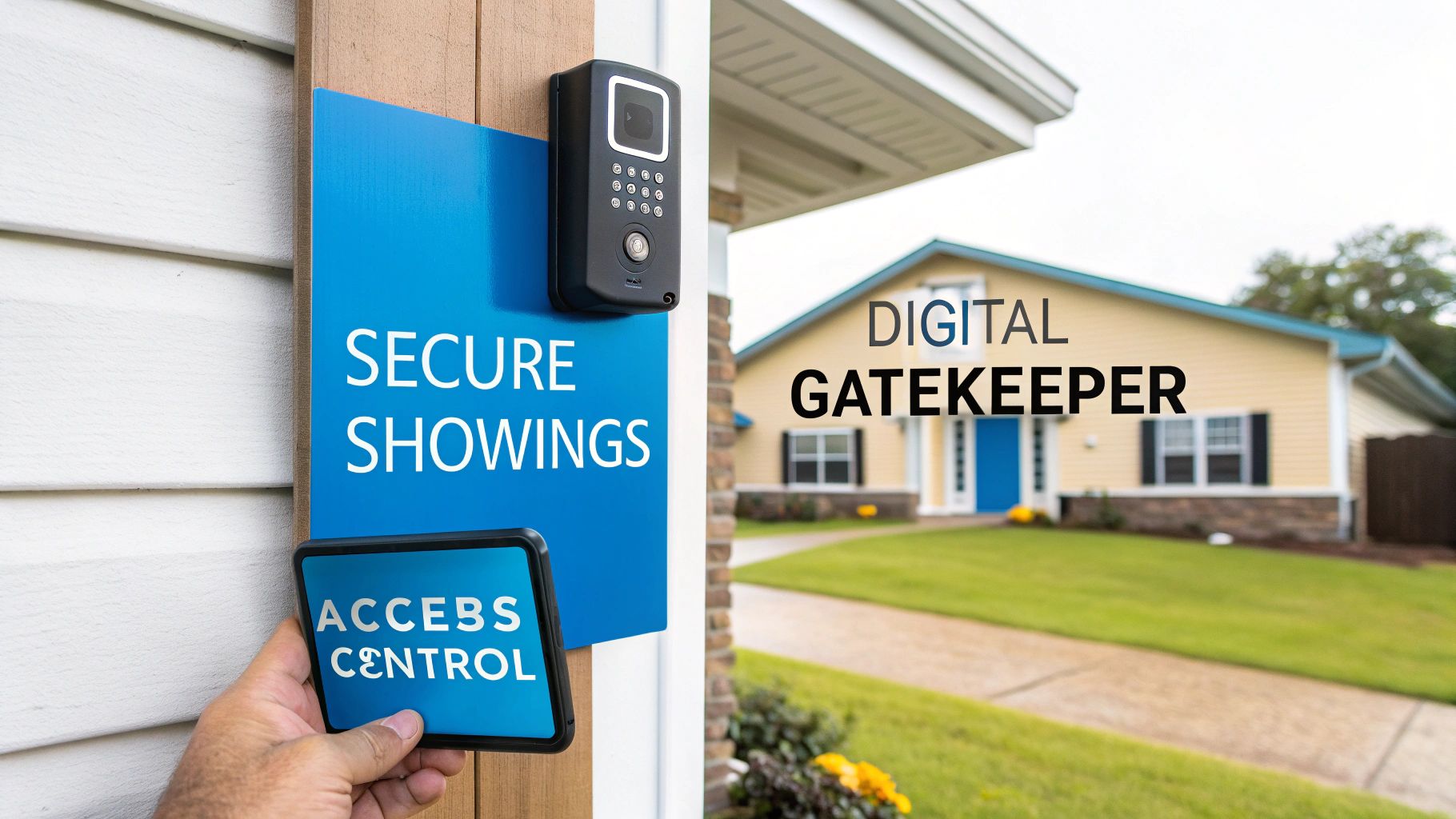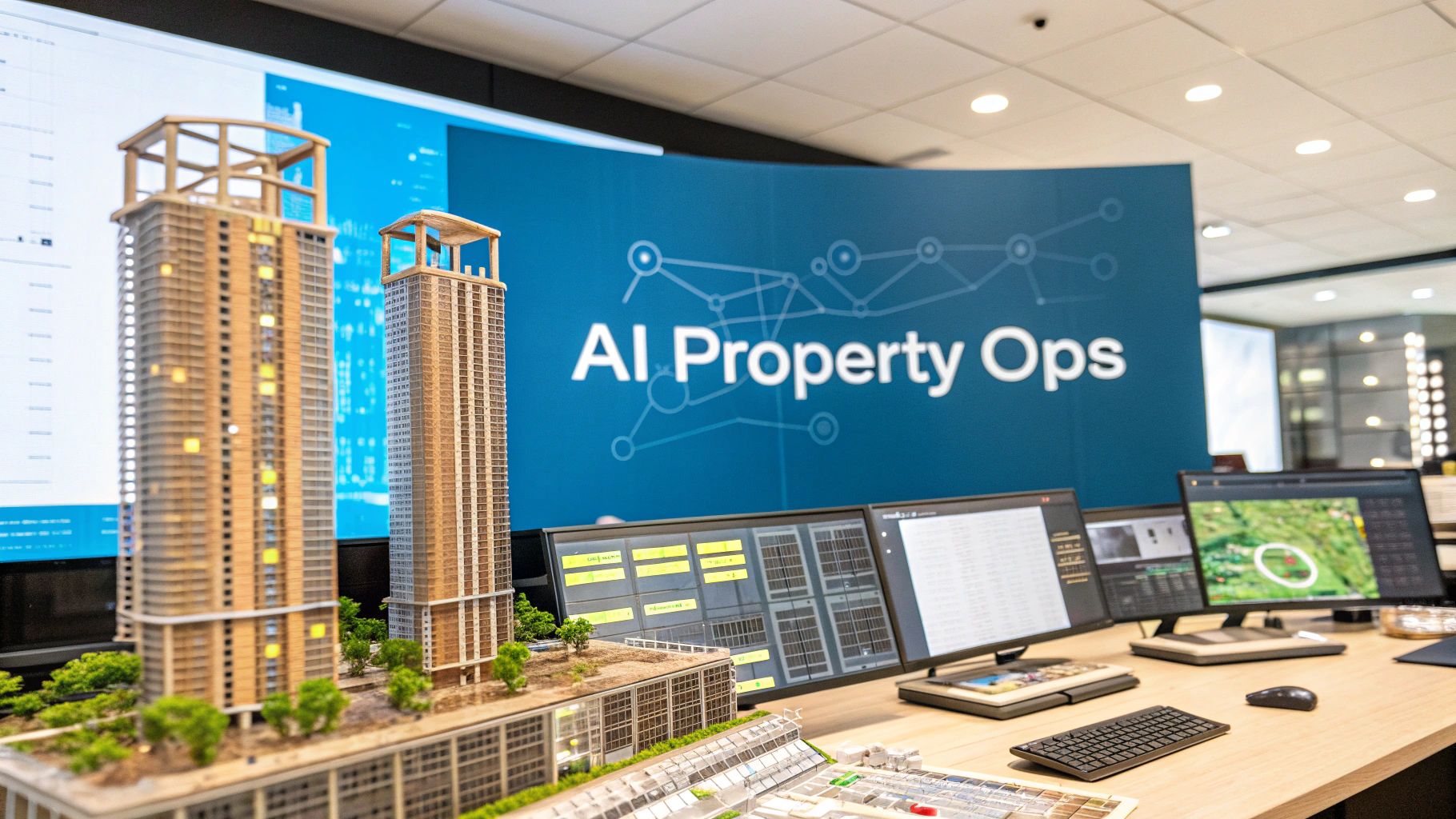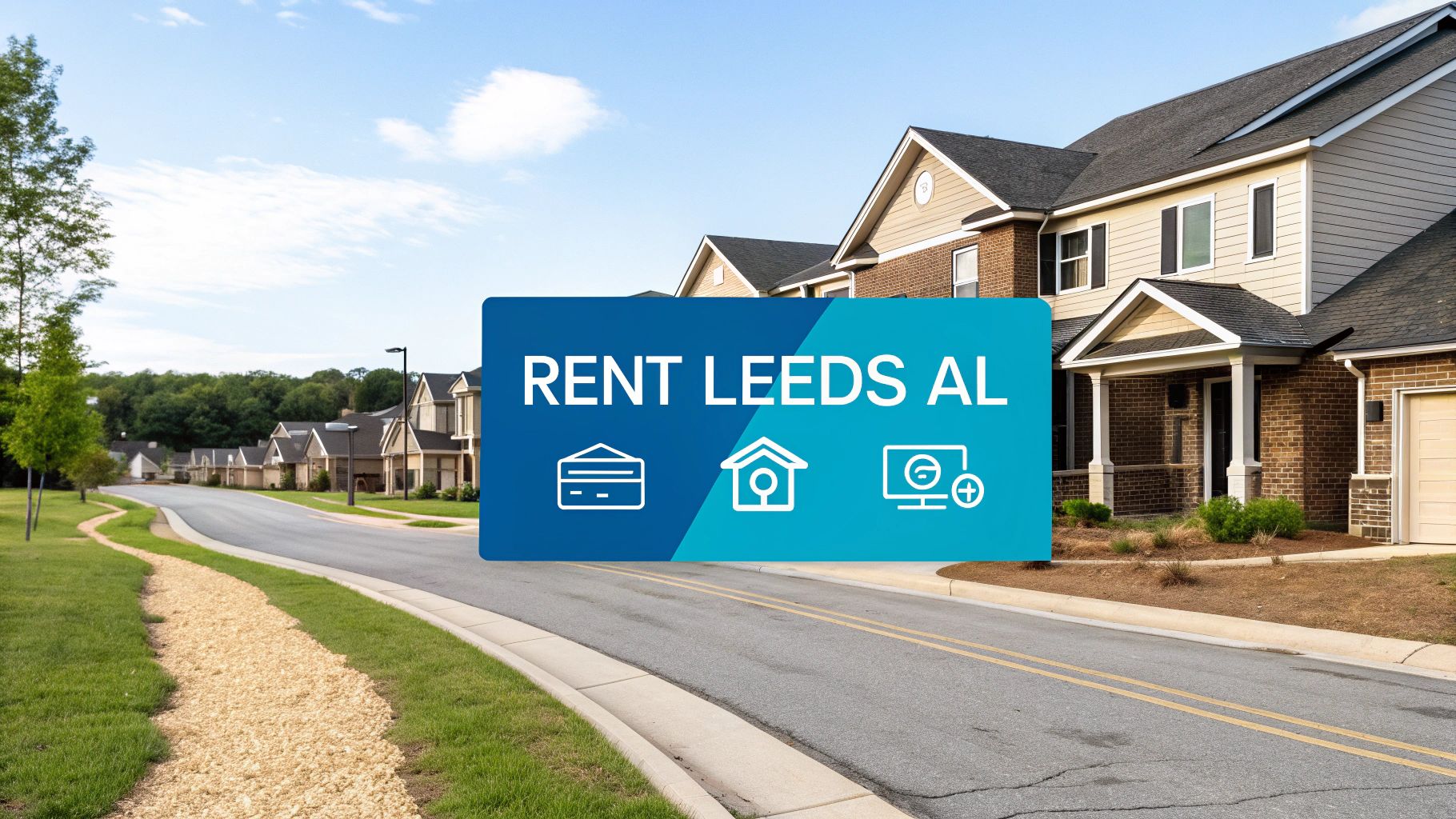For property management companies managing 100 to 10,000+ units, a lockbox isn't just a box for a key—it's a critical component of a scalable leasing engine. Learning how to use lockbox systems strategically isn't about convenience; it's about transforming property access from a logistical bottleneck into a competitive advantage that directly reduces vacancy loss and accelerates revenue capture across your entire portfolio.
Why Lockboxes Are a Strategic Asset for Enterprise Property Management

When managing hundreds or thousands of scattered-site properties, every day a unit sits vacant is a direct hit to your NOI. The legacy method—manual coordination between prospects and leasing agents—is a primary driver of high Days on Market (DOM). This process is operationally inefficient, fails to scale, and introduces friction that causes qualified, high-intent leads to abandon the process.
A modern lockbox strategy changes the game. By integrating smart lockboxes with an automated showing platform, property managers can offer the on-demand access today’s renters expect. This represents a fundamental operational shift from manual coordination to automated, self-service leasing—a non-negotiable for large-scale portfolios focused on efficiency and speed-to-lease.
Connecting Lockbox Strategy to Core KPIs
The true value is realized when you tie lockbox implementation directly to your most critical performance metrics. Secure, automated access is a powerful lever for measurable operational improvement.
- Drastically Reduce Days on Market (DOM): Enabling prospects to tour a property the same day they inquire—often within the hour—collapses the lead-to-tour timeline. This speed directly shaves off vacancy days, which translates into significant revenue recovery. For a 1,000-unit portfolio, cutting just a few days from your average DOM can recover tens of thousands of dollars monthly.
- Increase Lead-to-Tour Conversion Rates: By eliminating scheduling friction, you dramatically increase the percentage of qualified leads who complete a showing. A seamless, instant tour scheduling experience maintains prospect engagement before they move on to a competitor's listing.
- Enable True Operational Scalability: An integrated lockbox system creates a standardized, repeatable access protocol across all properties and markets. This allows you to grow your portfolio without a proportional increase in headcount, directly improving your cost-per-door efficiency.
The core principle is simple: the faster a qualified prospect gets through the door, the faster a lease gets signed. An integrated smart lockbox system is the most efficient and scalable way to execute this at scale.
When managing a distributed portfolio, your lockbox system is a cornerstone of your remote operational strategy. An optimized system enables seamless, secure management; a poor one creates security vulnerabilities and logistical chaos. The decision boils down to one critical choice: mechanical versus smart lockboxes.
For any multi-market operator, legacy mechanical lockboxes are an operational liability. Every tenant move-out or vendor visit requires a physical trip to change a static code. This is an inefficient, costly time sink that becomes unmanageable across hundreds of scattered units.
Smart Lockboxes: The Only Scalable Solution for Large Portfolios
Smart lockboxes solve the challenges of remote management by providing centralized control and a verifiable digital audit trail. For any property management company focused on operational excellence and systemization, they are the only logical choice.
Here’s why they are operationally superior:
- Remote Access Control: Generate unique, time-sensitive access codes from a central dashboard. Grant a prospect a one-hour window for a self-showing or provide a vendor access for a specific maintenance task without anyone leaving the office.
- Verifiable Activity Logs: Smart lockboxes track every access event in real-time. This data is invaluable for security, vendor verification, and operational accountability.
- Enterprise System Integration: Leading smart lockboxes integrate directly with your Property Management Software (PMS) and showing platforms like Showdigs, automating the entire leasing workflow from lead capture to lease signing.
This is not theoretical; the impact on operational efficiency is significant.
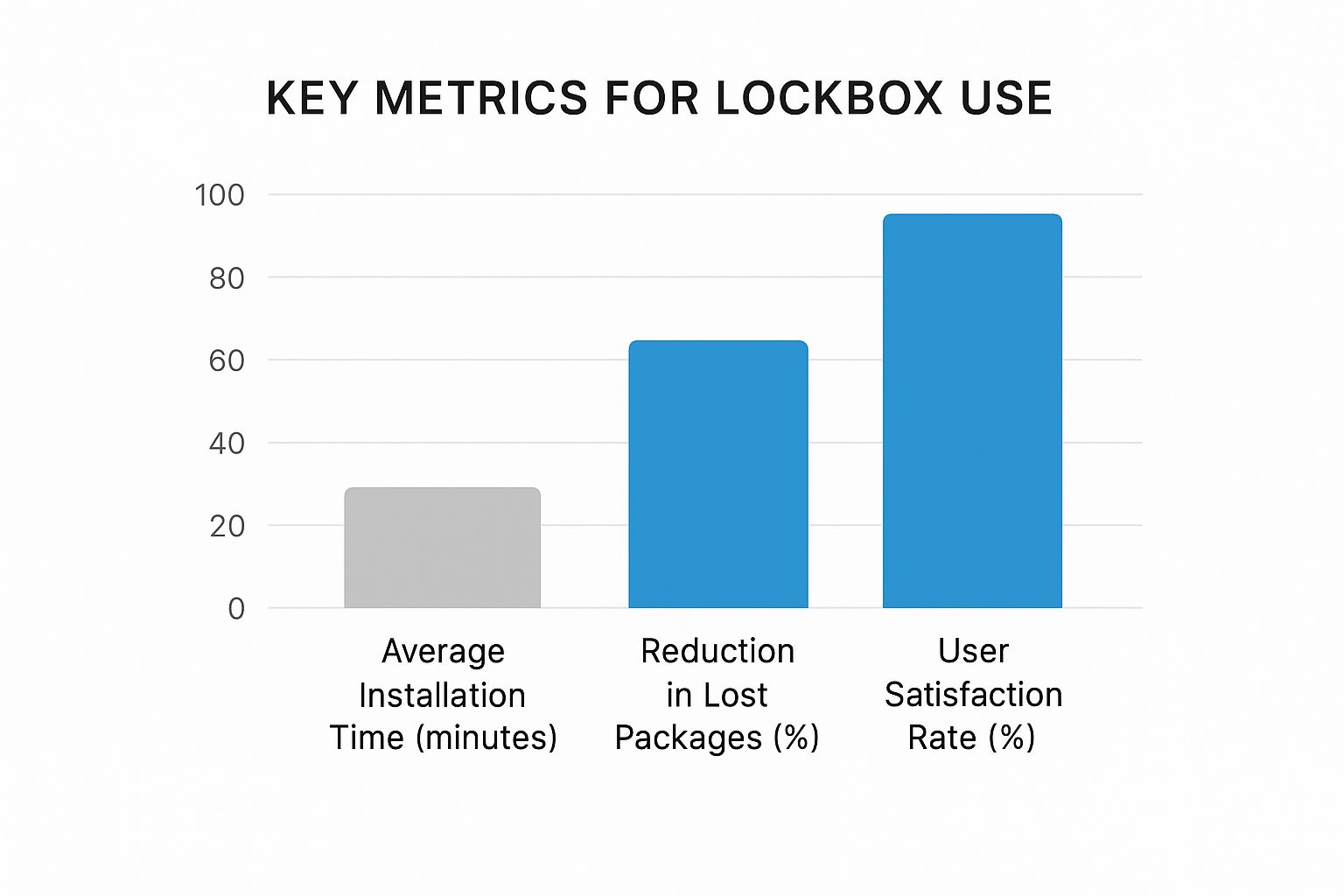
As shown, while initial setup is quick, the long-term ROI is driven by radical improvements in security, process standardization, and the prospect experience.
Comparing Lockbox Types for Scalable Property Management
To put it in perspective, here’s how the two options compare for a growing, multi-market portfolio.
The conclusion is clear: for any large-scale property management operation, smart lockboxes are a foundational technology for secure and efficient remote management.
Security and Market Trends
The demand for secure, remote access solutions is accelerating. The global key lock box market is projected to reach USD 1.9 billion by 2033, driven by the need to secure unattended assets in distributed portfolios. You can review the key lock box market data on Data Insights Market. For large-scale operators, this trend underscores the importance of investing in systems with robust security and integration capabilities.
When vetting a lockbox provider, API integration should be a non-negotiable requirement. This is essential for connecting your access system to your core operational software, creating a single source of truth that automates workflows and directly reduces Days on Market.
Creating a Standardized Lockbox Deployment Process
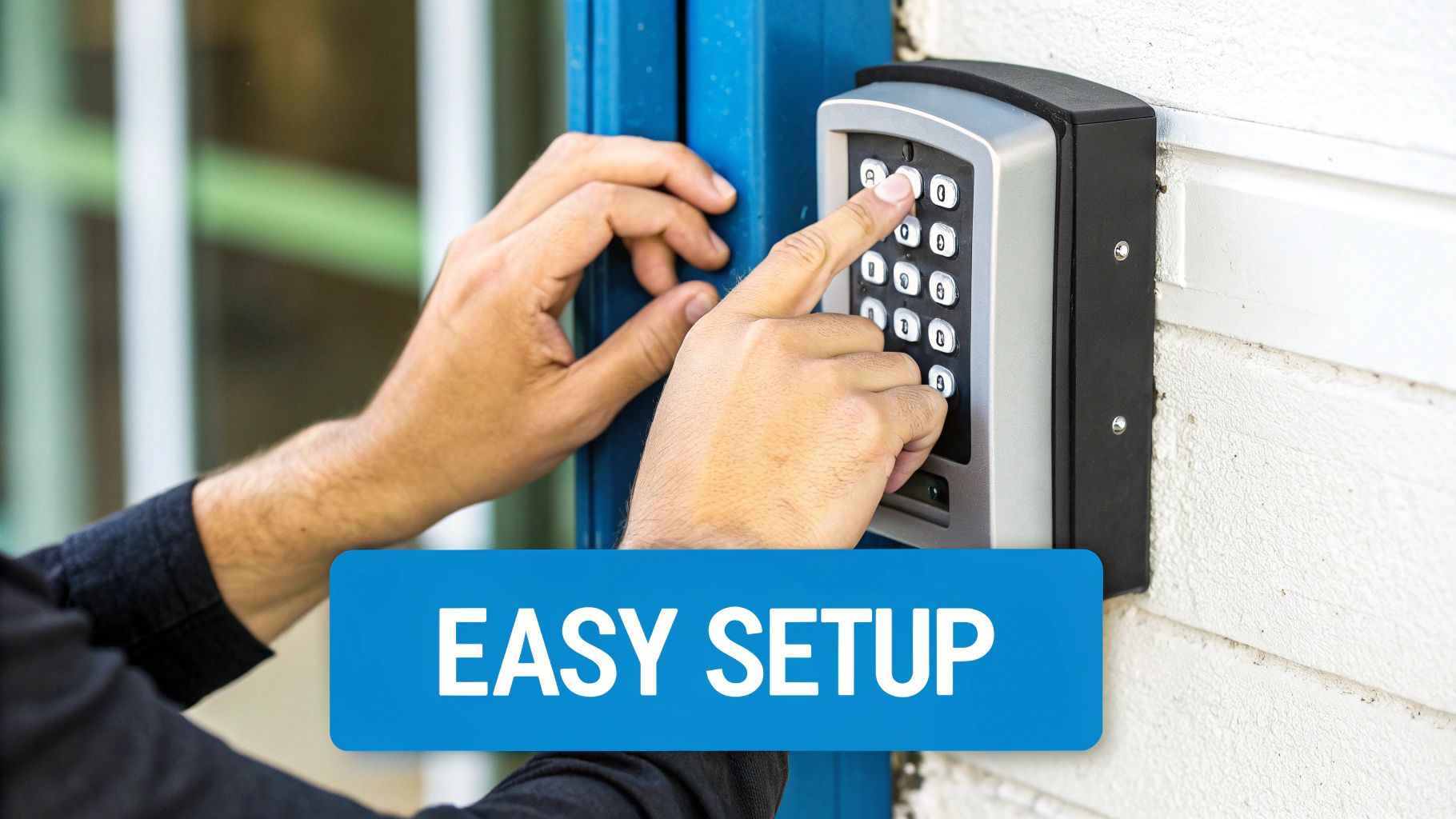
Consistency is paramount when managing properties across different submarkets or states. Without a standardized lockbox deployment process, operational chaos is inevitable. Inconsistent procedures lead to failed showings, security gaps, and frustrated leasing agents. A documented, repeatable system is what enables scalable, high-quality operations.
The process begins with a clear, non-negotiable installation protocol. Your field team must know exactly where a lockbox is placed on every property, every time. The objective is to ensure they are secure and easily found by prospects with instructions, but not conspicuous to passersby. Inconsistent placement—on a doorknob one day, a temporary fence post the next—creates unnecessary risk and operational friction.
Establishing Your Installation Blueprint
The most effective way to ensure enterprise-wide compliance is to create a simple, visual Standard Operating Procedure (SOP). A one-page guide with photos illustrating correct ("Do this") and incorrect ("Don't do this") placements is highly effective. This document should be a core component of your employee onboarding process and a required step in your property turnover checklist.
Your installation standards should be built on these key principles:
- Secure Anchor Points: This is non-negotiable. Lockboxes must be affixed to a permanent structure, such as a sturdy porch railing, gas meter pipe, or secured hose bib. Never permit attachment to doorknobs, which can be easily removed or cause damage.
- Discreet But Accessible Placement: The lockbox should be easily located by a prospect following directions but not advertise "vacant property" from the street. This detail helps deter tampering.
- Photo Confirmation: Require the installer to capture a timestamped photo of the installed lockbox and upload it to the property's file in your management software. This creates a verifiable record, ensures accountability, and simplifies remote troubleshooting.
A lockbox left on the ground or dangling from a loose gutter is more than an inconvenience; it’s a significant security liability and a threat to the asset you are contracted to protect. Standardizing placement is a simple policy that prevents major problems.
Proactive Inventory and Maintenance Management
Once deployed, lockboxes are assets that require active management. A centralized system to track each lockbox by serial number to its assigned property is essential. This is critical not only for inventory control but also for remote troubleshooting of access issues.
For smart lockboxes, proactive maintenance is key to operational continuity. A dead battery can cause a failed showing and increase your Days on Market (DOM). Your system should generate automated low-battery alerts, providing your team a 7-10 day window for replacement. This simple workflow prevents the scenario where a highly qualified prospect arrives for a tour only to be met with a dead lockbox and a locked door, destroying the prospect experience.
Automating Property Showings with Integrated Lockboxes
Manual showing coordination is the single biggest inhibitor to scaling leasing operations. For property managers with large portfolios, true efficiency is unlocked by integrating smart lockboxes with a showing automation platform. This is how you transition from being a "key courier" to managing a streamlined, on-demand leasing pipeline that meets modern renter expectations.
The entire workflow is automated. A prospect finds your listing, clicks to schedule a tour, and the system takes over. It verifies their identity, confirms availability, and automatically sends a unique, single-use access code directly to their smartphone.
The Power of On-Demand Access
This level of automation directly eliminates the primary bottleneck in leasing: scheduling friction. It eradicates the back-and-forth between a leasing agent and a prospect. The entire process, from inquiry to tour, can be completed in minutes without manual intervention. This enables same-day showings, a critical advantage for converting high-intent leads who are ready to make a decision now.
- Skyrocket Your Lead-to-Tour Conversion: By offering immediate, on-demand tours, you capture leads at their peak point of interest. This has been shown to dramatically increase the percentage of prospects who physically tour the property.
- Optimize Staff Overhead: Automation frees your leasing team from low-value, time-consuming scheduling tasks. Their time can be reallocated to high-impact activities like following up with qualified applicants, negotiating leases, and improving resident relations.
The core benefit is speed-to-lease. An integrated system allows a prospect to go from online listing to inside the property in under an hour. This velocity is a massive competitive advantage that directly reduces vacancy loss.
Measuring the Financial Impact
The ROI on this automation is not abstract—it is quantifiable. Every day a unit sits vacant represents lost revenue. By accelerating the tour process, you can demonstrably shorten your Days on Market (DOM).
Consider this ROI calculation: for a 1,000-unit portfolio with an average rent of $1,800/month ($60/day), shaving just three days off your average vacancy period across the portfolio results in $180,000 in recovered annual revenue.
This is precisely why top-tier property managers are implementing self-showings with a smart lockbox; it connects directly to financial performance. This technology isn't a gimmick; it builds a more efficient leasing engine that protects revenue and enables portfolio growth without a linear increase in staffing. It transforms a simple lockbox into a strategic tool for maximizing asset performance.
Setting Up Your Security and Access Protocols
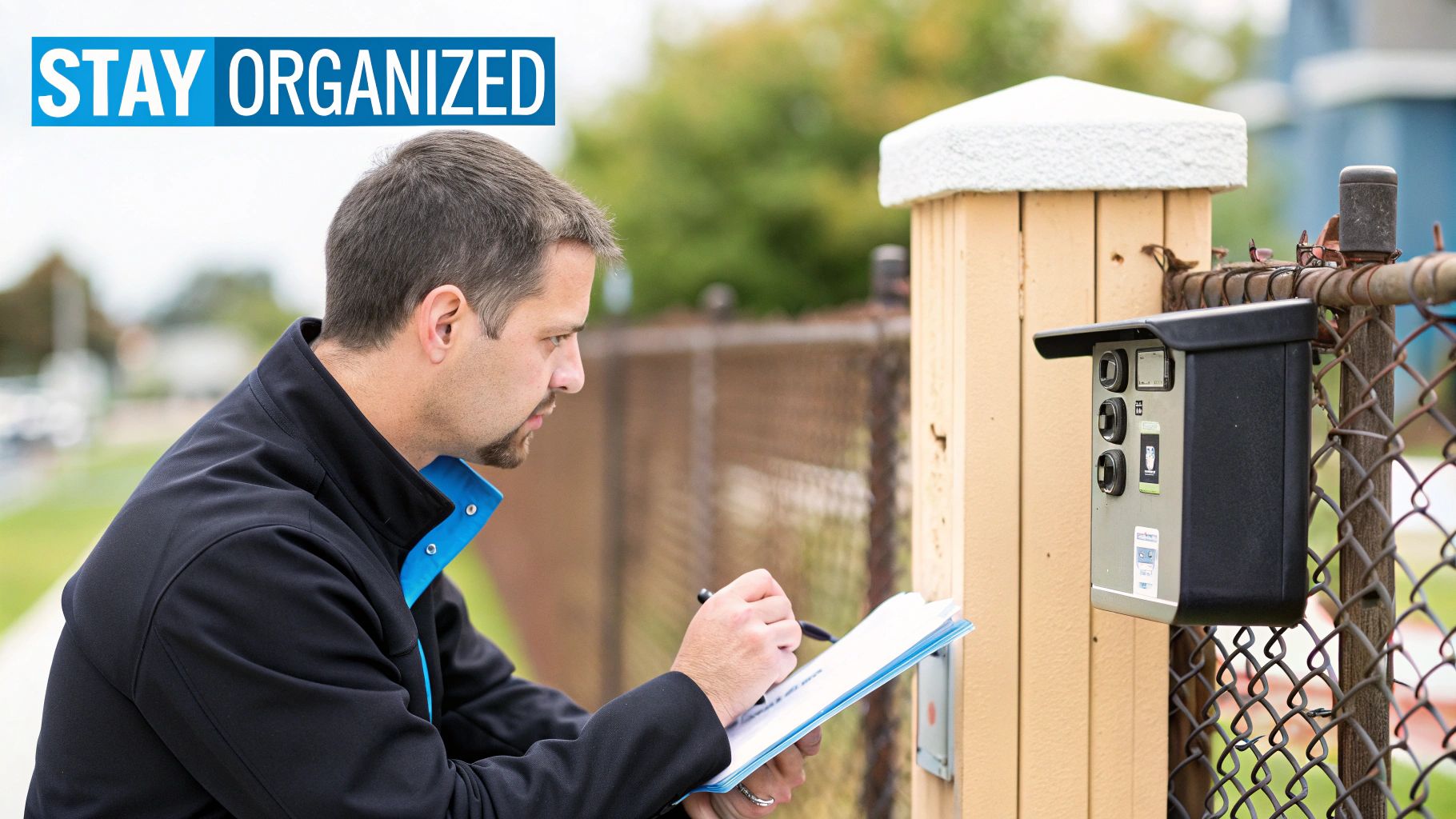
While speed-to-lease is a primary objective, asset protection is the foundation of property management. A robust security protocol ensures that operational velocity never compromises safety. For any large-scale portfolio, this requires abandoning the "one code for everyone" approach in favor of granular, role-based access controls.
The guiding principle is simple: every individual requiring access receives a unique, trackable code. This is a non-negotiable security measure. Your system must provide an immediate, verifiable record of whether a prospect, a vendor, or an internal agent accessed a property.
Create Clear Access Tiers
To maintain security and organization at scale, establish role-based access levels.
- Prospective Tenants: Codes must be temporary and single-use, set to expire shortly after the scheduled tour. This prevents unauthorized re-entry.
- Vendors and Maintenance: Grant time-boxed access. If an HVAC technician is scheduled for Tuesday from 1-3 PM, their code should only function within that specific window, eliminating open-ended contractor access.
- Internal Team: While staff may have longer-term codes, regular audits are crucial. Codes must be deactivated immediately upon an employee's separation from the company.
The most powerful feature of modern smart lockboxes is the activity log. This digital audit trail is your single source of truth, detailing precisely who entered a property and when. It is invaluable for resolving disputes, verifying vendor work orders, and ensuring accountability.
This is not simply a best practice; it reflects an industry-wide shift. The global lockbox market is expected to grow to USD 11.8 billion by 2035, driven by enterprise adoption of smart technology to tighten access control. A strong security posture not only protects the asset but also builds owner and resident trust, which can be as impactful as other apartment leasing incentives to fill vacancies.
Got Questions About Lockboxes? We’ve Got Answers.
When property managers deploy smart lockboxes at scale, several key questions consistently arise. Here are the answers operations leaders need.
How Do Smart Lockboxes Really Make Properties More Secure?
The primary security enhancement is the digital audit trail. Legacy mechanical boxes use static codes that can be shared and persist indefinitely. In contrast, smart lockboxes generate a unique, time-sensitive code for every user.
This provides a detailed, real-time log of who entered a property and when. More importantly, access can be revoked instantly from a central dashboard. This eliminates the risk of compromised codes and provides verifiable control over asset access—a critical function when managing hundreds or thousands of properties.
What's the Biggest Mistake PMs Make With Lockboxes?
The most common and costly mistake is failing to establish and enforce a standardized operational process. Without a clear, documented system for lockbox placement, code management, and battery maintenance, operational chaos is guaranteed.
When different teams or markets follow their own procedures, it creates confusion, security vulnerabilities, and failed showings that result in lost leads. A lack of process standardization completely negates the efficiency gains the technology is designed to deliver.
How Does Lockbox Integration Actually Boost Revenue?
Integrating your lockboxes with a showing platform like Showdigs drives revenue by directly reducing your Days on Market (DOM). By enabling automated, on-demand showings, you convert interested leads into physical tours almost instantly, collapsing the leasing timeline.
Consider the financial impact: every day a property is vacant represents lost revenue. If you can reduce the average vacancy period by just five days across a 500-unit portfolio, you can recapture tens of thousands of dollars in annual revenue.
Of course, documenting the property's state before and after showings is also crucial. You can learn more about the importance of condition reports in protecting your assets during the leasing cycle.
Ready to slash your Days on Market and automate your leasing operations? Discover how Showdigs uses smart lockbox integration to get properties leased faster. Learn more at https://showdigs.com.




